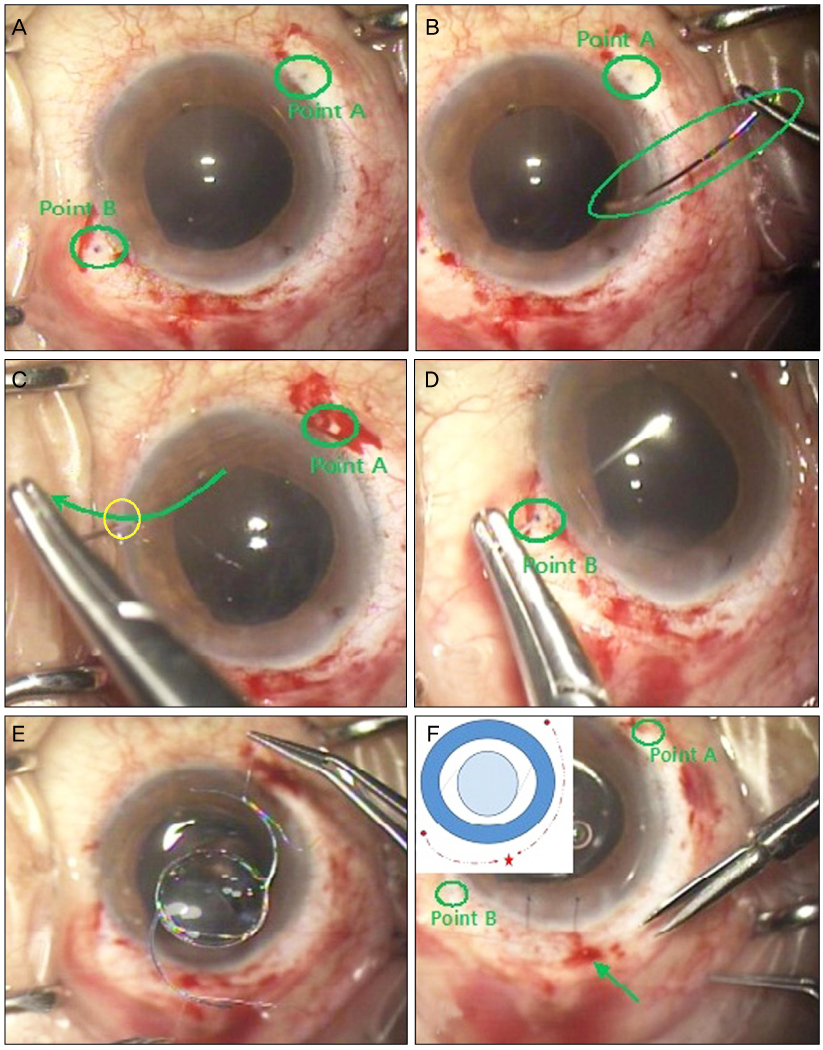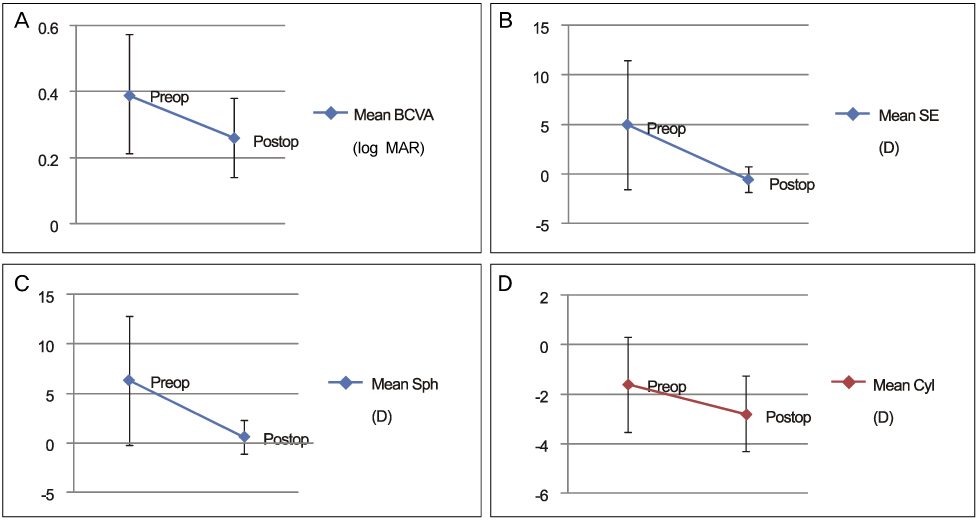J Korean Ophthalmol Soc.
2012 Dec;53(12):1783-1788. 10.3341/jkos.2012.53.12.1783.
Clinical Results of Modified Ab Externo and One-Knot Technique
- Affiliations
-
- 1Department of Ophthalmology, Chosun University School of Medicine, Gwangju, Korea. ophkoh@hanmail.net
- KMID: 2216391
- DOI: http://doi.org/10.3341/jkos.2012.53.12.1783
Abstract
- PURPOSE
To introduce a more efficient and time-saving scleral fixation technique for a posterior chamber foldable intraocular lens and to report the clinical results.
METHODS
A foldable acrylic 3-Piece IOL was sutured to the sclera via a small corneal incision. The guiding hollow needle was not used, which differs from other ab externo techniques. Instead, the curved long needle was directly pulled out through the cornea. The scleral flap was not used to bury the scleral suture knot; Instead, the scleral suture knot was translocated at the temporal area.
RESULTS
A total of 30 cases were studied retrospectively. The mean follow-up period was 2 years. The IOL was correctly positioned in all cases. There were no major complications, such as endophthalmitis or suture erosion through the conjunctiva.
CONCLUSIONS
Based on the authors' experience, the modified ab externo and one-knot technique is a faster and easier technique than the conventional ab externo technique.
Keyword
MeSH Terms
Figure
Cited by 2 articles
-
Astigmatic Changes and Clinical Outcomes after Scleral Fixation of IOL
Shin Yeop Oh, Sang Soo Kim
J Korean Ophthalmol Soc. 2014;55(10):1452-1459. doi: 10.3341/jkos.2014.55.10.1452.Long-Term Results of Transscleral Fixation of Posterior Chamber Intraocular Lens
Jong Rok Oh, Young-Hoon Ohn
J Korean Ophthalmol Soc. 2016;57(1):43-49. doi: 10.3341/jkos.2016.57.1.43.
Reference
-
1. Malbran ES, Malbran E Jr, Negri I. Lens guide suture for transport and fixation in secondary IOL implantation after intracapsular extraction. Int Ophthalmol. 1986. 9:151–160.2. Regillo CD, Tidwell J. A small-incision technique for suturing a posterior chamber intraocular lens. Ophthalmic Surg Lasers. 1996. 27:473–475.3. Kaynak S, Ozbek Z, Pasa E, et al. Transscleral fixation of foldable intraocular lenses. J Cataract Refract Surg. 2004. 30:854–857.4. Yepez JB, de Yepez JC, Valero A, Arevalo JF. Surgical technique for transscleral fixation of a foldable posterior chamber intraocular lens. Ophthalmic Surg Lasers Imaging. 2006. 37:247–250.5. Taskapili M, Gulkilik G, Engin G, et al. Transscleral fixation of a single-piece hydrophilic foldable acrylic intraocular lens. Can J Ophthalmol. 2007. 42:256–261.6. Oh HS, Chu YK, Kwon OW. Surgical technique for suture fixation of a single-piece hydrophilic acrylic intraocular lens in the absence of capsule support. J Cataract Refract Surg. 2007. 33:962–965.7. Szurman P, Petermeier K, Jaissle GB, Bartz-Schmidt KU. A new small-incision technique for injector implantation of transsclerally sutured foldable lenses. Ophthalmic Surg Lasers Imaging. 2007. 38:76–80.8. Fass ON, Herman WK. Sutured intraocular lens placement in aphakic post-vitrectomy eyes via small-incision surgery. J Cataract Refract Surg. 2009. 35:1492–1497.9. Kim SJ, Lee SJ, Park CH, et al. Long-term stability and visual outcomes of a single-piece, foldable, acrylic intraocular lens for scleral fixation. Retina. 2009. 29:91–97.10. Taskapili M, Gulkilik G, Kocabora MS, Nilay K. Transscleral fixation of single-piece hydrophilic acrylic lenses with no eyelets. Ophthalmic Surg Lasers Imaging. 2009. 40:434–436.11. Yaguchi S, Yaguchi S, Noda Y, et al. Foldable acrylic intraocular lens with distended haptics for transscleral fixation. J Cataract Refract Surg. 2009. 35:2047–2050.12. Schechter RJ. Suture-wick endophthalmitis with sutured posterior chamber intraocular lenses. J Cataract Refract Surg. 1990. 16:755–756.13. Lewis JS. Ab externo sulcus fixation. Ophthalmic Surg. 1991. 22:692–695.14. Choi KS, Park SY, Sun HJ. Transscleral fixation by injector implantation of a foldable intraocular lens. Ophthalmic Surg Lasers Imaging. 2010. 41:272–275.15. Kim DH, Heo JW, Hwang SW, et al. Modified transscleral fixation using combined temporary haptic externalization and injector intraocular lens implantation. J Cataract Refract Surg. 2010. 36:707–711.16. Lewis JS. Sulcus fixation without flaps. Ophthalmology. 1993. 100:1346–1350.17. Baykara M, Avci R. Prevention of suture knot exposure in posterior chamber intraocular lens implantation by 4-point scleral fixation technique. Ophthalmic Surg Lasers Imaging. 2004. 35:379–382.18. Hoffman RS, Fine IH, Packer M. Scleral fixation without conjunctival dissection. J Cataract Refract Surg. 2006. 32:1907–1912.19. Szurman P, Petermeier K, Aisenbrey S, et al. Z-suture: a new knotless technique for transscleral suture fixation of intraocular implants. Br J Ophthalmol. 2010. 94:167–169.20. Solomon K, Gussler JR, Gussler C, Van Meter WS. Incidence and management of complications of transsclerally sutured posterior chamber lenses. J Cataract Refract Surg. 1993. 19:488–493.
- Full Text Links
- Actions
-
Cited
- CITED
-
- Close
- Share
- Similar articles
-
- A Reverse Ab Externo Scleral Fixation for Posterior Chamber Intraocular Lens Dislocation
- Same Quadrant Trabeculectomy after Failed Ab Externo Open Conjunctiva XEN Stent Implantation
- A New Technique of Arthroscopic Meniscal Repair -Modified Inside-Out Technique
- Laparoscopic Extracorporporeal Knot Thying Using an Instrument for Knot Pushing and Tightening
- YS knot: A new technique for a tension-controlled slip knot using a trocar



